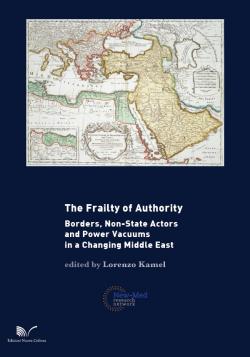The Frailty of Authority. Borders, Non-State Actors and Power Vacuums in a Changing Middle East
In Medio Oriente i fallimenti nella governance, insieme alle condizioni sociali, economiche, ambientali e demografiche del 21° secolo, hanno contribuito a spianare la strada per l’ascesa di attori non statali e parastatali molto eterogenei. Lo Stato è irrimediabilmente minato o l’attuale transizione porterà alla nascita di nuove entità statali? Come conciliare il crollo degli Stati e la ridefinizione dei confini con l’acuirsi della tradizionale competizione tra Stati, inclusa quella attraverso guerre per procura? Come concepire e immaginare un potenziale nuovo ordine regionale? Questo volume offre un retroscena storico e risposte politiche a queste e a numerose altre questioni connesse, analizzando gli sviluppi nella regione dal punto di vista dell’interazione tra disintegrazione e polarizzazione.
Volume prodotto nell'ambito della rete di ricerca New-Med.
List of contributors, p. 7-8
List of abbreviations, p. 9
Preface, by Nicolò Russo Perez, p. 11-14
Introduction, by Lorenzo Kamel, p. 15-18
1. Early Warning Signs in the Arab World That We Ignored – And Still Ignore, by Rami G. Khouri, p. 19-34
2. The Weakness of State Structures in the Arab World: Socio-Economic Challenges from Below, by Francesco Cavatorta, p. 35-49
2.1 The revenge of regions
2.2 Overcoming exceptionalism
3. State Vacuums and Non-State Actors in the Middle East and North Africa, by Florence Gaub, p. 51-65
3.1 What is a state vacuum?
3.2 A binary relationship: states and non-state actors
3.3 State formation in the Middle East and North Africa
3.4 Beyond state vacuums
4. Proxy Agents: State and Non-State Alliances in the Middle East, by Kristina Kausch, p. 67-83
4.1 Non-state actors as a foreign policy tool
4.2 Influential alliances
4.3 Proxy agents, statehood and regional stability
4.4 Increasing agency in a global context
5. (In)security in an Era of Turbulence: Mapping Post-Statist Geopolitics in the Middle East, by Waleed Hazbun, p. 85-105
5.1 The geopolitics of (in)security in the Middle East
5.2 Statist order in the Middle East: From consolidation to erosion
5.3 Towards a geopolitics of turbulence
5.4 The dynamics of hybrid actors and networks
5.5 The reconfiguration of US power in the region
5.6 A regional conflict of networks
5.7 Lessons from the Lebanese case
6. Hybrid Partnerships in Middle East Turbulence, by Raffaele Marchetti and Yahya Al Zahrani, p. 107-121
6.1 From Westphalia to transnationalism
6.2 Hybrid partnerships
6.3 Hybrid politics in the Middle East
6.4 Future trends
7. A “Natural” Order? States, Nations and Borders in a Changing Middle East, by Lorenzo Kamel, p. 123-140
7.1 “Artificiality” and the Middle East: Deconstructing a pattern
7.2 “Artificial” states and peoples: cui prodest?
7.3 A “natural” order?
7.4 Toward a “post-artificial” perspective
Bibliography, p. 141-160




